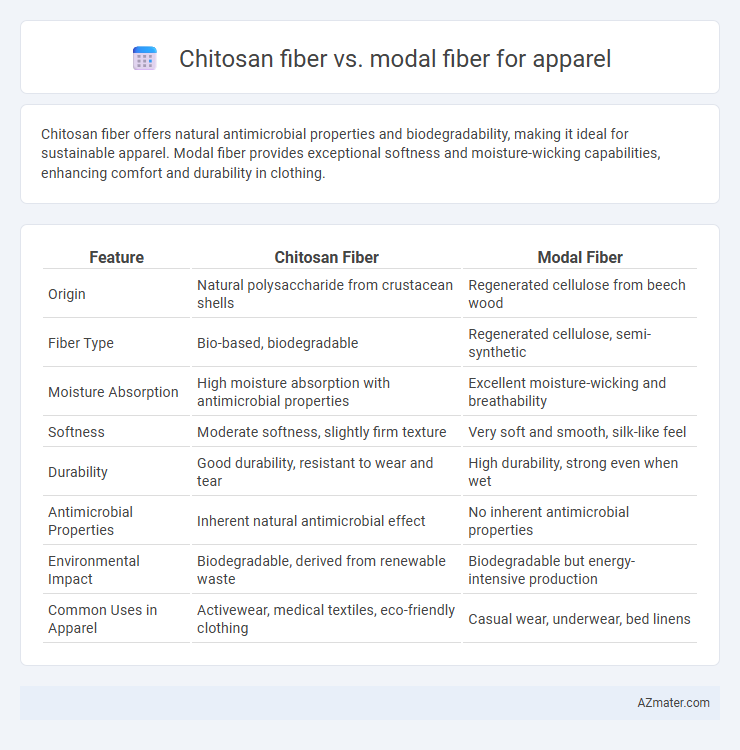Chitosan fiber offers natural antimicrobial properties and biodegradability, making it ideal for sustainable apparel. Modal fiber provides exceptional softness and moisture-wicking capabilities, enhancing comfort and durability in clothing.
Table of Comparison
| Feature | Chitosan Fiber | Modal Fiber |
|---|---|---|
| Origin | Natural polysaccharide from crustacean shells | Regenerated cellulose from beech wood |
| Fiber Type | Bio-based, biodegradable | Regenerated cellulose, semi-synthetic |
| Moisture Absorption | High moisture absorption with antimicrobial properties | Excellent moisture-wicking and breathability |
| Softness | Moderate softness, slightly firm texture | Very soft and smooth, silk-like feel |
| Durability | Good durability, resistant to wear and tear | High durability, strong even when wet |
| Antimicrobial Properties | Inherent natural antimicrobial effect | No inherent antimicrobial properties |
| Environmental Impact | Biodegradable, derived from renewable waste | Biodegradable but energy-intensive production |
| Common Uses in Apparel | Activewear, medical textiles, eco-friendly clothing | Casual wear, underwear, bed linens |
Introduction to Chitosan and Modal Fibers
Chitosan fiber, derived from chitin found in crustacean shells, offers natural antibacterial properties and biodegradability, making it ideal for sustainable apparel. Modal fiber, a semi-synthetic cellulose fiber sourced from beech tree pulp, provides exceptional softness, breathability, and moisture absorption. Both fibers serve distinct roles in textile manufacturing, with chitosan focusing on health benefits and eco-friendliness, while modal emphasizes comfort and durability.
Raw Material Sources and Sustainability
Chitosan fiber, derived from chitin found in crustacean shells, offers a renewable and biodegradable alternative to Modal fiber, which is produced from beech tree pulp through intensive chemical processing. Chitosan's raw material is typically sourced from seafood industry waste, promoting circular economy benefits and reducing environmental impact compared to the wood-based Modal fiber that requires considerable water and energy consumption. The biodegradability and antimicrobial properties of chitosan fibers enhance sustainability in apparel by minimizing microplastic pollution and extending garment lifespan, whereas Modal's sustainability depends heavily on responsible forestry and closed-loop manufacturing systems.
Fiber Production Processes
Chitosan fiber production involves extracting chitosan from crustacean shells, followed by dissolving it into a viscous solution and spinning it into fibers through wet spinning, offering natural antimicrobial and biodegradable properties. Modal fiber is produced from beech tree cellulose through a chemical process involving alkali treatment, bleaching, and extrusion through fine spinnerets, resulting in soft, breathable, and moisture-wicking fibers. While chitosan fibers emphasize biopolymer extraction and eco-friendly processing, modal fibers rely on advanced cellulose regeneration techniques for high-quality textile applications.
Physical and Mechanical Properties
Chitosan fiber exhibits excellent antimicrobial properties, high moisture absorption, and biodegradability, making it ideal for eco-friendly apparel. Modal fiber offers superior tensile strength, softness, and durability with excellent wrinkle resistance and dimensional stability. Compared to Modal, Chitosan fiber tends to have lower mechanical strength but provides enhanced skin-friendly features and odor control.
Moisture Absorption and Breathability
Chitosan fiber, derived from chitin in crustacean shells, exhibits superior moisture absorption due to its natural hydrophilic properties, effectively wicking sweat and enhancing comfort in apparel. Modal fiber, a semi-synthetic cellulose fiber, offers excellent breathability and softness but has comparatively lower moisture absorption capacity than chitosan fiber. For performance apparel requiring rapid moisture management and antimicrobial benefits, chitosan fiber provides a competitive edge over modal fiber.
Antibacterial and Skin-Friendly Features
Chitosan fiber exhibits strong antibacterial properties due to its natural biopolymer structure, effectively inhibiting bacterial growth and reducing odor in apparel. Modal fiber is renowned for its exceptional softness and breathability, promoting skin comfort but lacking inherent antibacterial features. Combining chitosan's antimicrobial benefits with modal's skin-friendly texture can enhance apparel performance, making fabrics suitable for sensitive skin and hygienic wear.
Biodegradability and Environmental Impact
Chitosan fiber, derived from chitin in crustacean shells, offers superior biodegradability compared to modal fiber, which is a semi-synthetic cellulose-based material. Chitosan fiber decomposes rapidly in natural environments, reducing landfill accumulation and promoting eco-friendly waste management, while modal fiber, though biodegradable, requires longer degradation periods and specific conditions. The production of chitosan fiber involves less chemical processing and utilizes renewable marine waste, resulting in a lower environmental footprint than the energy-intensive modal fiber manufacturing process.
Comfort and Wearability in Apparel
Chitosan fiber offers excellent moisture absorption and antimicrobial properties, enhancing comfort by keeping the skin dry and reducing odor in apparel. Modal fiber is known for its smooth texture and high breathability, providing a soft, lightweight feel ideal for prolonged wear. Both fibers improve wearability, but chitosan's natural bioactivity gives it an edge in hygiene-sensitive clothing, while modal excels in softness and drape.
Cost and Market Availability
Chitosan fiber is generally more expensive than Modal fiber due to its bio-based extraction process and limited large-scale production, impacting cost-efficiency for apparel manufacturers. Modal fiber benefits from wide market availability and established mass production, making it a cost-effective choice for mainstream apparel brands. The higher price and constrained supply of Chitosan fiber restrict its use primarily to niche markets emphasizing sustainability and antimicrobial properties.
Applications in Modern Apparel Industry
Chitosan fiber is prized in the modern apparel industry for its antibacterial, biodegradable, and moisture-wicking properties, making it ideal for activewear, medical textiles, and eco-friendly fashion. Modal fiber offers exceptional softness, breathability, and durability, commonly used in casual wear, underwear, and luxury loungewear. The sustainable nature and functional benefits of Chitosan fiber contrast with Modal's comfort and performance, allowing designers to innovate across various apparel segments.

Infographic: Chitosan fiber vs Modal fiber for Apparel
 azmater.com
azmater.com